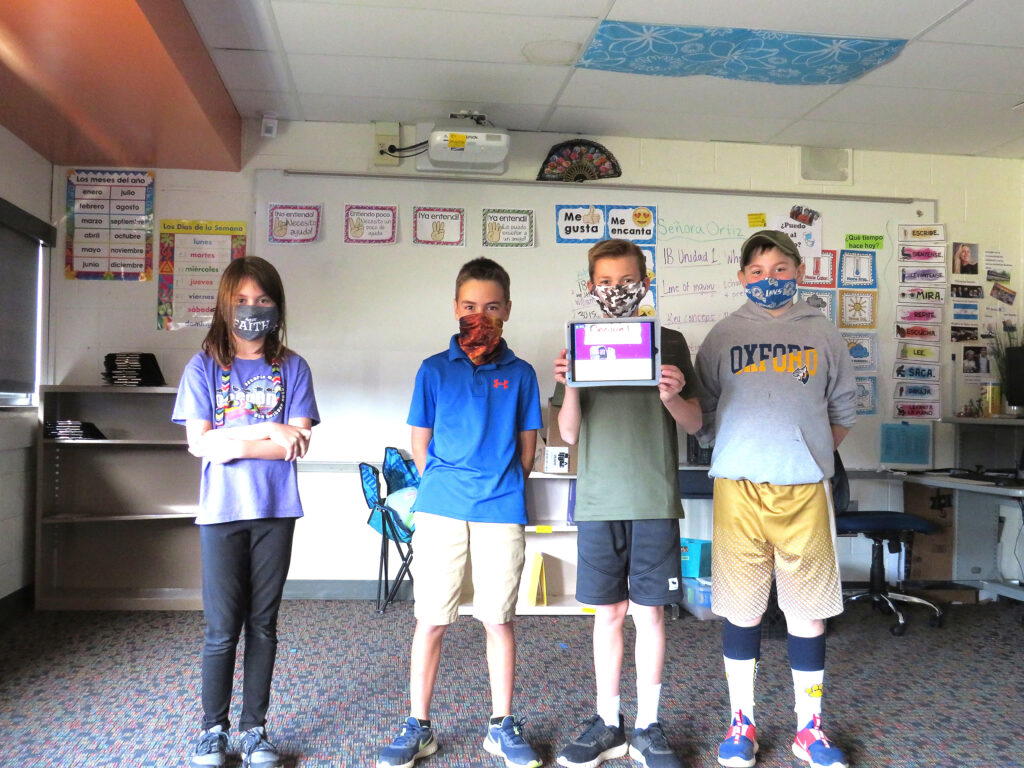
By Teddy Rydquist
Leader Staff Writer
Oxford Elementary School, made up of third through fifth-grade students and located at 109 Pontiac Street, has used the changes to the school day caused by the coronavirus (COVID-19) as a way to implement a new activity into their lesson plans, one that has been a hit with students.
A few days each week, students use the provided Apple iPads to play “Bloxels,” an application which allows users to build their own video games and share the created art, characters and stories within that game with their classmates.
“Oakland Schools has a STEM (science, technology, engineering and mathematics) program, where they’re the owners of the iPads, the licenses for Bloxels, the licenses for CoSpaces, which we’re looking for next, and they can access all the schools within Oakland County,” said Oxford Elementary School Principal Jeff Brown.
“The cool part of this is it allows us to checkout these things directly from Oakland Schools, without actually having to make the purchases ourselves. So, it’s a true partnership. The way we’ve specifically been involved is a former Oxford teacher, Phil Kimmel, is one of the two main teachers for the STEM program through Oakland Schools. We obviously have a great relationship with him, and he came out last year with another person named Kyle Kilpatrick, he’s the other co-director of this, and they made a sales pitch to all of our teachers and showed us probably ten different products we could use. We have now started choosing what we thought would be the most fun and the most interesting for kids, and Bloxels is the first one we’ve brought up.”
This new addition to the school day has not only been a change for students, but the teachers have also devoted time to learning these new applications.
“For this year especially, ‘fun’ is one of our big goals,” Brown, who is in his 12th year as Principal at Oxford Elementary, said.
“What I ask the teachers to do is play along with the kids, and our goal is to have about six different platforms come this year, every six weeks, we’re going to rotate it in for a new kind of game or new experience. My goal for this year is just to have the teachers see what it is, we’ll figure out where it fits in our curriculum, but we have to do the play part first, we have to see what it’s capable of.
“In this game (Bloxels), there’s like eight different color blocks and the blocks can all do different things. The white block is like a story block, where you can type in words or paragraphs or phrases, so, you get to this point in the game and you can type text. I can see teachers doing something fun with it that way, with kids writing stories, developing characters and things like that.”
In their final year at the elementary level before making the jump to middle school in 2021-22, four fifth-grade students joined us to share their favorite part of the game.
“What I like best about Bloxels is you can, instead of playing the levels people have already made, you can make your own game,” said CJ Ascroft, who serves as his classroom’s leader, tasked with attending the Zoom assembly earlier this year describing the game and then relaying that information to his classmates.
“You can make your own character, make any character you want, any different thing. You can change your blocks however you want it to look. You can make the ground look like bricks and stuff. That’s my favorite part about the game.”
“You can add different animations,” Gage Burns chimed in. “I made this block where it’s full-size, then it shrinks until it’s nothing and then goes back out.”
Cameron Clark also appreciates the possibilities this game offers.
“My favorite part is the creativity,” he shared. “Like CJ (Ascroft) said, you can build whatever you want, you don’t have to stick to that one thing.”
Avery LaPine echoed her classmates’ claims.
“I like how in Bloxels, anything is possible,” she said. “If you don’t want to play your own game, you can play other peoples’ games, and everyone can do it.”
Most importantly, Brown and his staff have chosen to implement this with an eye on the future, hoping to show their students applications like this can lead to career opportunities down the road.
“From my perspective, from a school perspective, what I really would like the kids to see is, everyone wants to be an athlete because they can see that job. I like to play basketball, so I want to be a basketball player.
“What I’m hoping for our kids to do, we have all kinds of kids who love video games, but there’s a million different jobs connected to all of these games. You might not like to play video games, but you might be really good at art, and designing all those animations and backgrounds is really important.
“We just want the kids to see some of things they’re learning in school are directly applicable to a possible career they might want. When I went to school, there was very little of talk of, ‘My career should be something I’m interested in, it’s not just work?’
“You kind of forget, the people that are most passionate about what they do, it is because they love it. Trying to get the kids to understand at an early age, take the things you love and then try to figure out how to make a career out of that, you’re going to have a much happier life.”

Leave a Reply